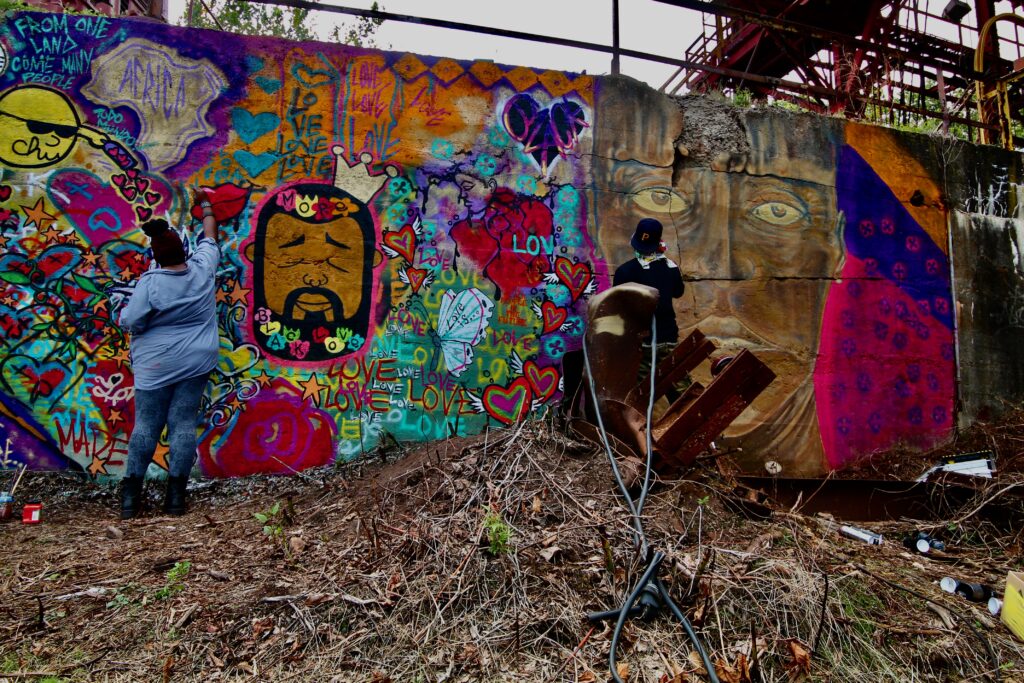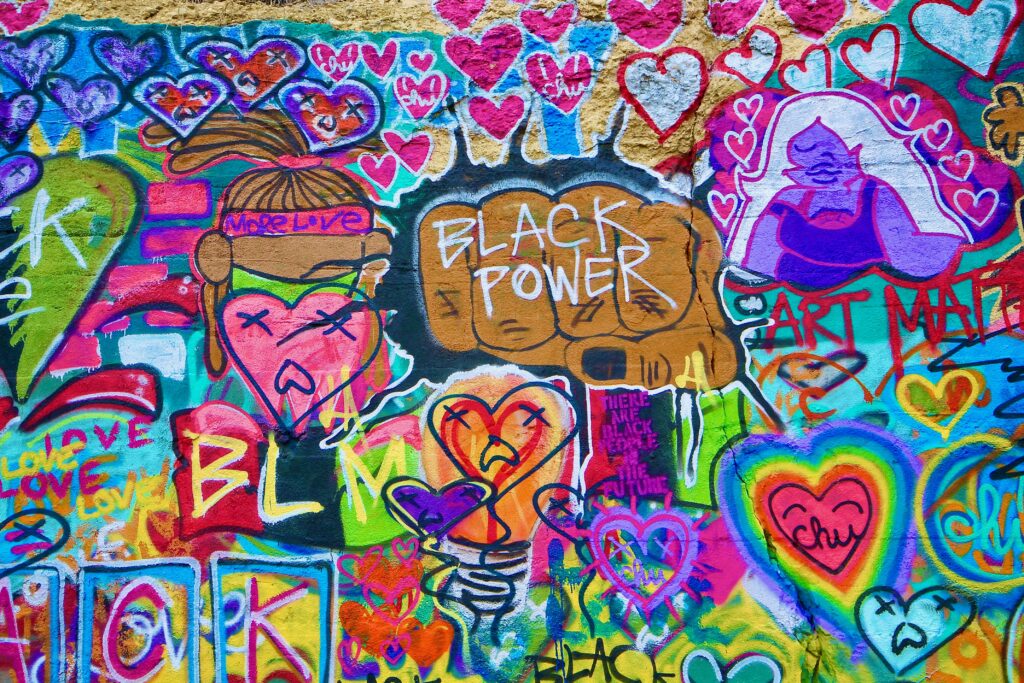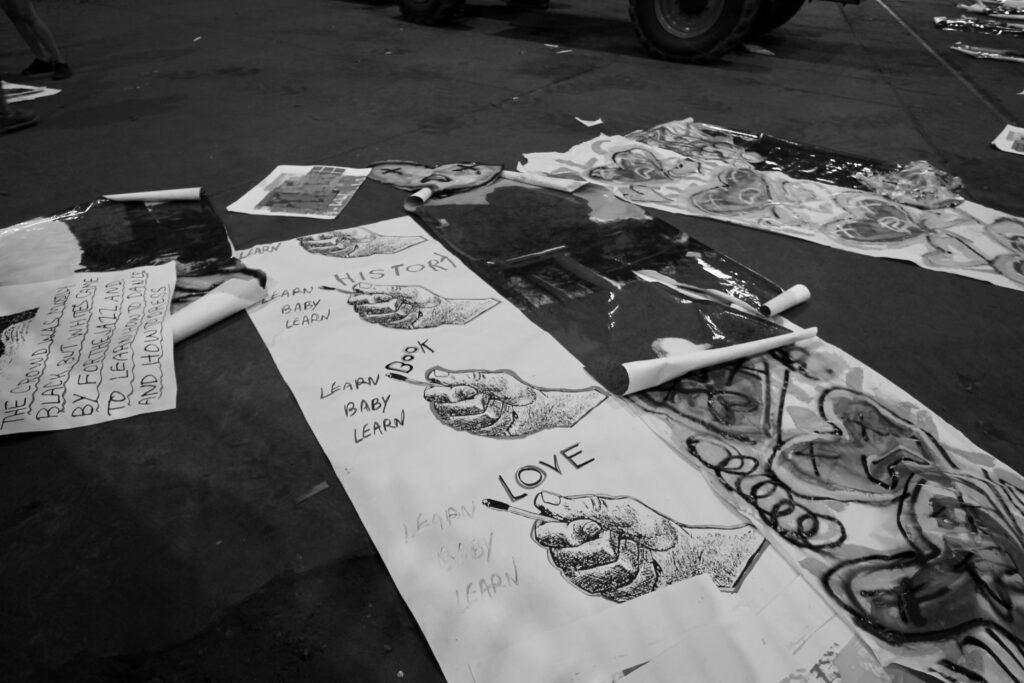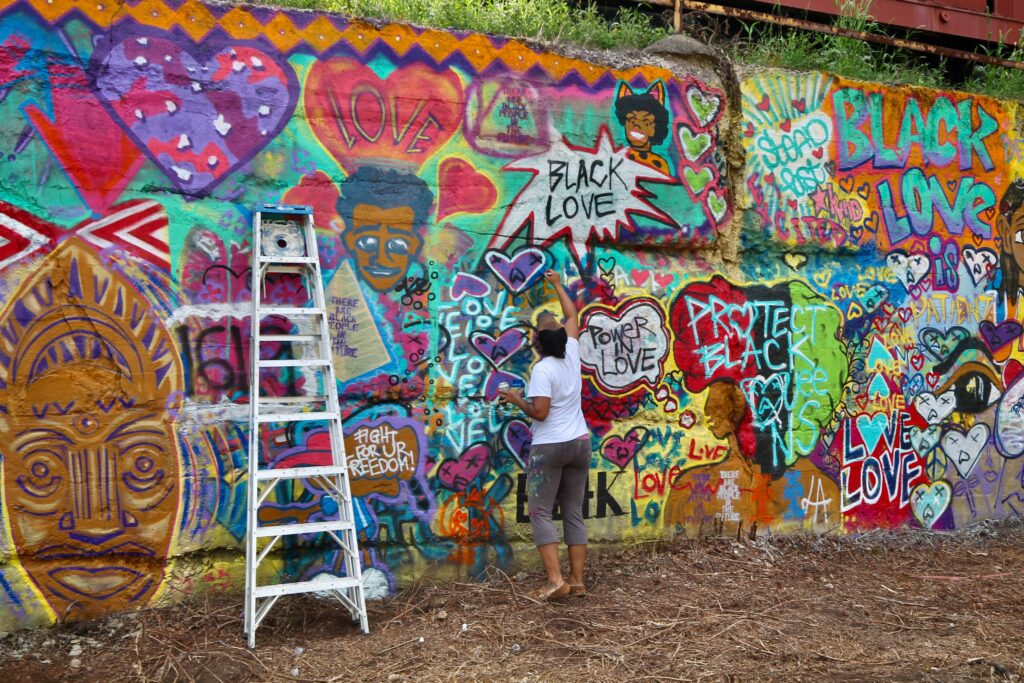
This month, Boom Concepts partnered with Rivers of Steel to create a mural at the Furnaces as part of a two year series. The mural, organized, produced and curated by D.S. Kinsel, explores the thematic of “Black on Black Love,” and lays the groundwork for a broader interrogation of the value of including Black voices in the interpretive work that occurs at the Carrie Furnaces and the greater Pittsburgh area. This work can nuance collective reflection about the intersections of industrial labor, postindustrialism, creativity, muralism, graffiti, street art and place-making and place-keeping in the Mon Valley.

Between September 8th to September 12th, a talented intergenerational group of multidisciplinary Black artists came together to create two collaborative public art projects following the theme “Black on Black Love”. The projects include: a mural and a series of six wheat pasted collages in the power house at the Furnaces.
I was honored to get to see the completion of the mural on a sunny Saturday. Approaching it from the pathway between the furnace and the powerhouse, its multicolored arrangement was magnetic.

The mural is a palimpsest of energy. “There’s a lot of a frenetic energy going on, a lot of energy on the wall,” one of the participating artists, Kemist, explained. With a colorful background, each of the 12 artists contributed texts and iconography in a collage-like aesthetic. In the idiom of the graffiti worlds I am more familiar with it feels like a “free wall,” a space of collaboration, dialogue, and play that occurs in an improvised framework. Free walls are alive. To be able to play that way, though, requires trust. To let your work be abutted and recombined with others’. In that sense the mural performs an ethic of love– the give and take, the dialogic, taking risks with form and style but being supported.
Kinsel discussed the process with Boom collaborating with Rivers of Steel (who provided access to the site, storage, ground support): “Boom is super happy to provide space for artists to create freely. We did a week-long installation where artists were provided the theme of ‘Black on Black Love’ and given free reign to collaborate, interact, engage, go over each other’s work on a 100 foot by 20-30 foot wall– it’s really been more about artists building and connecting over the week and learning about each other, really a field building activity and the wall as the end result…we are happy Boom can provide these opportunities and make sure everyone gets paid.”
In terms of the pedagogical effect the mural might have Kinsel averred: “Just see different creative styles from Black artists. There’s twelve different people that participated and contributed and you can see that, it’s really apparent. You want to take some positive energy. The theme is Black on Black Love so oftentimes you don’t see that type of imagery or messaging submitted through art or through media or through commercials, so ideally we’d be providing some positive angle to the Black experience and Black existence. And maybe we get some shirts made of the sections. It’s really vibrant and really colorful. So thinking, too, what are the different ways to how to commodify this work for the artists as well.”

The variety of styles was evident the the mix of forms on display, but also phrases. In addition to “Black Love,” and “love, love, love” the wall included phrases like “Black art matters,” “Black power,” “1619”, “from one land come many,” “protect Black women,” “power in love,” “there are black people in the future,” “everyday I wake up and I know I’m being hunted,” “more black love, yinz” and “fight for ur freedom.” Hearts with little “chu” symbols and Kinsel’s signature hearts with little “x’s” for eyes and upside down hearts for mouths were scattered across the expanse of the wall. Resisting a singular narrative, the wall discloses a kind of eurythmic combination of multiple voices that are not collapsed into one.


The panoply of styles (cartoons, surreal, text styles, realist portraiture, and anime style images) were not limited to the wall across from the ore yard. In the powerhouse, Alisha B. Wormsley and Jim E. Kidd in collaboration with Dana Bishop-Root and Kinsel installed a wheat pasted collage of hand painted hearts, photo prints, and screen printed work. Some of Mr. Jim’s prints read: “Learn baby, learn/history/love/book” or “”the crowd was mostly black but whites came by for the jazz and to learn how to dance and how to dress.” He painted a light water-color like red around some of the prints, the sparest of color.
As Kinsel mentioned above, the work of creating a mural is as much about social process as it is about aesthetic produce. The mural is an event that allows for communion and community building, evident when friends of the artists stopped by and a mother and son got to paint together.
Danielle Robinson reflected of her experience painting: “It was fantastic. I was here for two days, and it was my first time out here and the vibe is so cool, I had a blast and it was something I needed to do, being a Black woman, female artist I needed to come out here and do this. It was important for me…. Black love is important. Love Black people is important.”

Takara Canty explained: “This was one of the best experiences of my life because I was able to work with other Black artists from Pittsburgh and from outside of Pittsburgh to collaborate, and to do something in dedication of George Gist. And it’s important, and it’s beautiful, and it’s lovely.” Of the site, she noted, “I’m glad we were able to fill this last portion of the wall with something so important.”

Kemist explained that he had helped with the background and did the portrait: “I saw a crack in the wall and I saw an eyeball, and I started building on that…it’s a cool experience. I was the second graffiti writer to come down here because when I first came into here in ’96 or so there was a tag on the wall but I didn’t know who it was, and then me and my friends started coming down, but I haven’t painted for a number of years…it’s almost surreal to be down here now and to be asked to come down here. I spent a LOT of time here so its really groovy to be part of this affirmation to long going events. Its the same thing people have been saying since 1492, probably. And just to be a part of this is like and at a place– this place has a lot of good memories for me…this is an affirmation of things people already know but some people choose to ignore. So its really groovy, man. I’ve never really painted anything like this, it’s not really my format…but it all makes sense… a lot of loose energy…its uplifting…and its a really important thing on the human family level to be part of something. There is enough negative and sad things and bad things in the world, so even if its just for a little while just to be part of something that is really good and positive…It’s funky”

Jerome “Chu” Charles mused: “It always feels nice when someone wants me to come along to a project, especially one that is going to have so much impact for the people seeing it for as long as it lasts on the wall.” In terms of what people can learn from the mural he responded: “I hope that they can learn that the fact that there is such a cry for more Black love– Black on Black on Black Love– when Darrell introduced the concept, Black on Black Love, I kept thinking about it; ‘What is that?’ and I thought about the opposite, which is Black on Black crime, violence, is what people talk about so much. So to see something that is specifically about love…what does that mean? Maybe there needs to be more of that. Maybe we need to learn to love each other more, all these kinds of things. So, I hope that’s what they can pull from this. Black on Black love is what we need. It’s very healing.” He speculated: “When you represent Black love, and Black kids see these images of themselves and stuff, even if it doesn’t now, hopefully these are things that can stick with them that they can reflect on and when it does really mean something to them we’ve already provided the space for that to exist.”

Natiq Jalil shared: “Working on this mural is amazing because I got to work with artists I had heard about and admired, and some of them I had never gotten to work with before. I feel like this was an opportunity for unity amongst artists that I rarely ever get to see. I’m all about taking away the competition aspect of art and bringing out more of the community aspect, so this meant a lot.” I asked Natiq what he hope the tour groups would learn from the work: “I hope they see the unity that Black artists can pull together, just this universal love that we have for people and for art and for beauty that is something that people don’t often see in the media and the way that we are represented, just in popular culture. So I hope that people see a whole different aspect to the Black American experience. This is a dedication to my mento, who was like a father to me, George Gist, and his whole life was about leaving a legacy for Black artists, so I feel like he would be so proud if he saw these artists come together to do a Black Love mural.”

The Graffiti Art Program at the Carrie Furnaces is one of the few permission sites for aerosol art in the region. As part of it, in a typical year, hundreds of visitors and school groups get to learn about the intersection of industrial history and the post-industrial art movement of graffiti.
Some, even lifelong Pittsburghers, had not heard of the Furnaces before, “I knew nothing about the site before and was amazed when I saw it and was like, ‘this is nothing but potential, this is a beautiful place.” Natiq added. Others, like Chu, who are part of the style writing community explained that the importance of the Furnaces, for them “is its status as a place for graffiti over the years, it was always a dream spot to go to, and you heard people talk about ‘oh Carrie Furnace, there’s old school graffiti pieces out there it’s really cool,’ so, when I finally made it out to Carrie Furnace it paint it was because of HCUAP (Hemispheric Conversations Urban Art Project), I got to paint with some artists that came out from Mexico…its funny that all of the times I have painted at Carrie Furnace have been legally, it feels very easy! I didn’t have to climb any fences or do anything like that.” Likewise, Kemist, an old school writer, had long knew about the Furnaces and painted there before Rivers of Steel took over as managers.
Kinsel explained how the site connected to labor history for him: “My family has a legacy here in Pittsburgh going back a few generations so the infrastructure of industry is important if you are a blue-collar Yinzer, which I am. Boom really takes a blue-collar approach to field building and helping artists develop. I think its awesome that the site has an industrial legacy and a graffiti and public art legacy and this project was the first time Carrie Furnaces had this many Black artists on the site–I don’t know how many of the other feature murals feature Black folks. We had Black women on the team participating, so a lot of significant firsts and a lot of participants in the project who are from Pittsburgh and their family have a legacy in Pittsburgh and it was also their first time, so, learning from both sides and hopefully it will be more.”
Kinsel concluded by connecting this project to the larger dialogue happening in Pittsburgh about Black artists in the public realm: “I see this as part of the response to the original Black Lives Matter mural done downtown and I think some of the challenges and the conflicts that were initially set and exposed in that action through the action at Spirit, the action at Fiasco and through the action here at Carrie Furnace, I think some understanding and some real community building has happened. And I think that is the biggest part and most important part and more Black artists got some opportunities so that’s ultimately one of our primary goals.”
Contributing artists included: Jim Kidd, Latika Ann, Takara Canty, Natiq Jalil, Darrell Kinsel, Jerome “Chu” Charles, Kemist1, Alisha Wormsley, Camo Customz, WavyWednesday, Danielle Robinson, Kuwame Kinsel and Universal Hunt.
